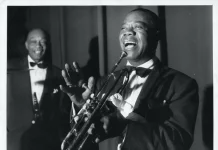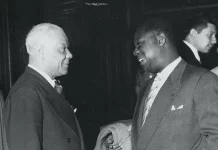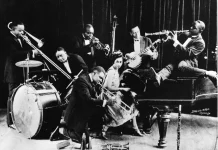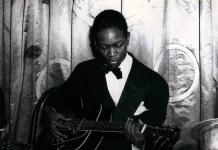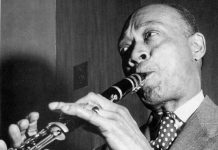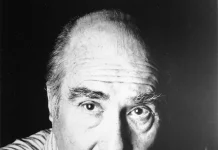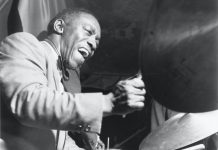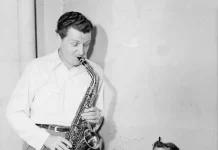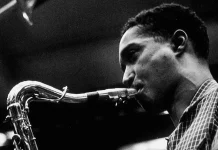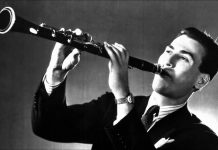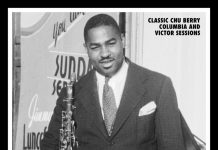It is said that to copy from one person is plagiarism. To copy from two is research.
I have consulted Dan Morgenstern and Jim Burns, two of the few writers who have struck the tenor player Gene Ammons more than a glancing blow (Jim had the misfortune to have his Jazz Journal article titled “Jean Ammons”). For a man who had 54 albums under his own name, Ammons has had minimal critical attention.
Son of and spoiled by the great blues and boogie-woogie pianist Albert Ammons, “Jug” was born in Chicago on 14 April 1925. (Billy Eckstine gave him the name when Ammons couldn’t find a hat big enough to fit his head. “You’ve got a head like a jug”, said Billy). He grew up in that city and began on clarinet at Du Sable High School where his music teacher was Captain Walter Dyett. Dyett’s incredible list of distinguished pupils included Nat Cole, Ray Nance, trombonist Bennie Green, Dorothy Donegan, Ahmad Jamal, Johnny Griffin and Richard Davis.
Jug had already made a name for himself as an outstanding tenor player by the time he was a teenager. Not much more is known about his childhood, except that he didn’t leave school until he was 18. While still at school he played with a variety of bands in the area, eventually climbing when he was 17, to become the featured soloist in the local band, one of Chicago’s finest in the early 40s, led by trumpeter King Kolax.
Ostensibly of the bop generation, he absorbed a lot of Lester Young’s style into his own, but not Lester’s sound. From the start Ammons had a big and warm tone, occasionally reminiscent of Coleman Hawkins, but also of Ben Webster and Chu Berry. His playing was thus cloaked in mainstream. He paid his respects to Charlie Parker, but was not overwhelmed by Bird’s style. Ammons’ rich handling of melodies led later to his having large and cosmopolitan audiences of his own.
Dan Morgenstern wrote vividly about “a big, gentle bear of a man who played the tenor saxophone with a sound and feeling synonymous with soul. His musical life spanned four decades, and he had hits in each of them – a record matched by few (if any) jazzmen. His music was direct and honest, and it reached and touched people”.
Ammons was well placed to ride the fad for tenor-and-organ groups that bloomed in the 50s. But the “big gentle bear of a man” became tragically involved in the evil fad that was the bane of his generation of jazz musicians. He became addicted to heroin and was jailed for it from 1958 to 1960, when he was paroled, but was not allowed to resume playing before an audience. Fed up with promises that he would soon be freed from this, he went back to playing anyway. He was accused of violating his parole and sent back to jail to serve another five months. Gene suffered from savage sentencing, for he was no more a criminal than the many other musicians who succumbed to the deadly habit. Deadly indeed for Gene, for his subsequent jailing, for seven years from 1962 to 1969, probably shortened his life, apart from removing him from the scene when his kind of music was prospering. Of this massive sentence, initially 15 years to life but reduced to 10 to 12 on appeal, he said “What it boiled down to, it seemed to me, was that they were going to make an example of me due to the fact that I had a fairly big name in the music business.
“The only thing I can say about it is the way I got into it was through curiosity”, Gene told Leonard Feather. “It’s just how far a man wants to go, and in my case I just didn’t have the forethought enough to stop when I should have. When I looked up, I was so deep in that I couldn’t get out.”
Fortunately the prison authorities recognised his value to them, and he was “put in charge of more or less everything in the music department”, allowed to direct, compose for and play in the prison band and also to take on students.
Because of this he was able on his release, in October 1969, to pick up his career as soon as his feet hit the ground again. But his ordeal wasn’t over, for in his last years he developed bone cancer, and endured this, playing until near the end, when he died on 6 August 1974.
I must admit to not having heard as many of Jug’s albums as I would have liked to have done, but on the other hand, listening to a majority of them would have been hard work because he was no good at editing himself, and tended to play long tracks for the sake of it when he had nothing new or coherent to say. Although basically a jazz player, Ammons used the language of rhythm and blues, and it was from the latter that most of his adherents came. Perhaps unfairly, this led to some downgrading of his value amongst jazz enthusiasts, and it wasn’t until long after his death that he was recognised as having been a major tenor stylist.
When Gene was on tour with Kolax in 1944, the band was heard by Billy Eckstine who quickly added the 19-year-old to his new and now legendary bebop big band where, over the next three years, Gene’s tenor associates included Dexter Gordon, Wardell Gray, Lucky Thompson and Budd Johnson. Dexter referred to part of the sax section as “the Unholy Four” – himself, altoist John Jackson, fellow tenorist Sonny Stitt and baritone Leo Parker. They were all energetically aggressive players. Stitt was to team up with Ammons eventually in a two-tenor front line that pedalled the excitement of their rowdy duets. In later years Ammons himself became an influence, with traces of his playing to be found in the works of Dexter Gordon, John Coltrane, Sonny Rollins and Ornette Coleman.
On Dexter’s departure Gene became the main soloist in the band.
It’s a platitude to say that the Eckstine band was underrated. In its three years it provided a home, at one time or another, for Charlie Parker, Dizzy Gillespie, Miles Davis, Freddie Webster, Doug Mettome, Bennie Green, Oscar Pettiford, Tommy Potter, Sarah Vaughan, Art Blakey, Shadow Wilson, Clyde Hart, John Malachi, George Wallington, Kenny Dorham, Lena Horne, Howard McGhee and Fats Navarro, as well as the four tenor player mentioned above and Ammons himself.
Gene solos along with Fats Navarro and John Malachi on Love Me Or Leave Me during one of the band’s Jubilee broadcasts collected on Spotlite SPJ-CD 200. The same arrangement appears with 23 other charts by the band on President PLCD 545.
Because the band’s records, abundantly reissued later, were then so obscure, the hotbed that Eckstine had created was largely unacknowledged amongst the innovators. If you can find any of them, albums by the Eckstine band are on Spotlite SPJ-CD200, Retrospective RTS 4252, Flapper Past CVD7086, Indigo 1GO CD 2069 and President PLC 545. There are many high spots, including several tenor duets. The President, the Flapper and the Spotlite have versions of Blowin’ The Blues Away, which feature Dexter and Gene in an early pairing of the two instruments. Both are on good form, and nobody gives an inch.
In January 1945, when Dexter had been with the Eckstine band for 18 months, he and the Unholy Four left. “Gene Ammons was a loner”, said Dexter. “He stayed.
“We had been fucking up, really – especially me – and wanted more bread. And Eckstine didn’t want to come up… I don’t know whether he didn’t want to or couldn’t.
“It was a very together reed section, so all the cats split. Of course, since that time – I’ve mellowed a little bit – I feel kind of bad about that. Because actually B was and is a great guy, and it was nothing he had done to me. It was just me, just youth.”
The loner Gene Ammons, who had by then been there for three years, much of the time as the featured tenor player, didn’t leave until Billy finally folded the band in February 1947 as it was uneconomic. Interestingly, at the time of the disbandment, the trumpet section included Miles Davis and King Kolax.
Eckstine went his own way, and Gene went back to Chicago where he formed his own group. He also showed his mainstream credentials when he recorded with his father Albert’s band. It was with Gene’s group at this time that Junior Mance first attracted attention.
His band became quite good, and Gene persisted with it until, in what seemed like a grotesque move, he joined Woody Herman’s band in the spring of 1949. He, Jimmy Giuffre and Buddy Savitt were the three tenors who had succeeded the recently departed Al Cohn, Zoot Sims and Stan Getz.
Shorty Rogers and Bill Harris were in that band, and Shorty had just written a splendid arrangement, More Moon, which is exactly what it was. The main feature is a lengthy solo from Gene played in a muscular version of the Getz tradition. Gene Ramey writes that Bill Harris solos “in full bluster” and indeed he does. Happily this and Ammons’ other feature on Not Really The Blues were both Herman classics of the time, for Gene doesn’t seem to have shown his head over the parapet on any of the band’s other recordings, although I can’t speak for the several dance and radio broadcast recordings of the time. After five months Gene left. In future he would work only as a leader.
Apart from, that is, on 6 February 1950 when Gene partnered George Auld in a tenor duet on Count Basie’s recording of Rat Race for RCA Victor. This is another eccentric appointment in the discography. The Basie octet had Sweets Edison and Dickie Wells with Count’s rhythm section.
When he was good, Gene was very good. Happily there is a place to hear him at his best. Gene Ammons Quintet & All Star Groups on Avid AMSC 1029. One might think that the three excellent albums on this one are a happy mischance, but experience with that label emphasises that somebody at Avid knows their stuff, and the catalogue is stuffed with “best” albums.
Jug’s first recordings were for EmArcy and the company was so impressed (one of the titles, Red Top, became a huge hit when Ammons recorded it again in 1953) that they signed him to a contract for the next two years. He made a swathe of 78s for the label and after the first session he used some musicians who were later to become renowned, including Junior Mance, bassist Eugene Wright and trombonist Matthew Gee. Lack of critical commotion indicates that these records were largely undistinguished.
Eventually Gene left EmArcy and eventually fetched up at Chess, whose equipment did better at capturing his full, warm tone, but some of the interpretations he gave of ballads could be described as mawkish.
Gene’s collaboration with Sonny Stitt created some corrosive tenor battles. First formed in 1950, their partnership was resumed at various points during the rest of Gene’s short life. With two such masters of the horn, it seemed that the music couldn’t fail. Apart from the abrasive stuff, the two featured contemporary ballads, and Ammons had a huge hit with his version of My Foolish Heart (apparently Billie Holiday chose Gene’s record of it as one of her 10 favourites in a contemporary poll).
It seems that the best of Ammons’ recordings were for the Prestige label.
I ordered a four CD set containing eight of those albums from Amazon to comment on them here. I suspended work on the piece prior to the set’s arrival. Twenty-seven days later it arrived. However, the wait was worth it, even though there are no discographical details given and it is a pest trying to sort out which tunes come from which albums. The set is on Enlightenment EN4CD9114 and according to the notes runs for almost five hours.
The first track, Hittin’ The Jug, is an eight-minute blues that opens with a long and typical piano solo from Tommy Flanagan which is as tasteful and expressive as one would expect. Jug enters, breathing authority, clarity and a basic simplicity. The hard edge to his tone gives him a stentorian sound which mixes joyfully into the blues eloquence. One is immediately reminded of the wonderfully declamatory blues C’mon In by Hawk with Charlie Shavers for the same label a year earlier. In both cases the music is basic but exemplary in showing the personality of the player. Doug Watkins is the bassist and Art Taylor the drummer. The session is marred only by the unnecessary addition of Ray Barretto’s clattering congas. There’s a supremely voluptuous My Romance sans Barretto – that’s two classics and we’re still only at track 3 on the first side! A gymnastic Confirmation follows where Taylor’s excellent accompaniment would have been better without the help from Barretto. Jug’s attack here is pithy and throughout the whole six tracks with Flanagan’s men.
The rest of the CD brings on the excellent Richard Wyands on piano and is equally good. Seed Shack is another good blues in the Hittin’ The Jug vein – if anything the tenor is more blistering. Ammons obviously liked to work with Barretto, for he appears with good pianists on other sessions – Patti Bown and Walter Bishop amongst them. He’s much more in place on a fine mainstream session where Gene locks well with organist Jack McDuff. A very on form Joe Newman is added on trumpet to these half dozen tracks. They’re all long with the oratory on Stormy Monday lasting over eight minutes and the ever-present Barretto fitting in nicely.
This isn’t intended as a review of the whole album, but in my listening so far I haven’t heard anything to really complain about. Some might think that Gene’s improvising can be rather obvious, as in lacking subtlety, but it all sounds good to me. There is an album of hymns that is unlikely to please God any more than it pleases me, but at least it’s melodic and has a lot of good tunes. I never thought that I would write that the Parker-Hawkins Abide With Me is better than Jug’s. The set pairing Ammons with Sonny Stitt doesn’t have the detonations I was expecting, with the two respecting each other and each soloing well over Jack McDuff and Charlie Persip. Oddly, given McDuff’s ubiquity, one misses the bass. But it’s a pleasant enough session with simple voicing between the soloists.
You can find the rest of the delights for yourself if you wish to. Certainly the best I’ve heard of Gene Ammons is contained here. The liner note writer wants a rap over the knuckles. “This albums brings together the entirety of Gene Ammons’s output released between 1950 and 1962.” There are eight albums here. I counted 19 in Tom Lord’s Discography that were issued on Prestige and recorded between 1961 and 1962.


